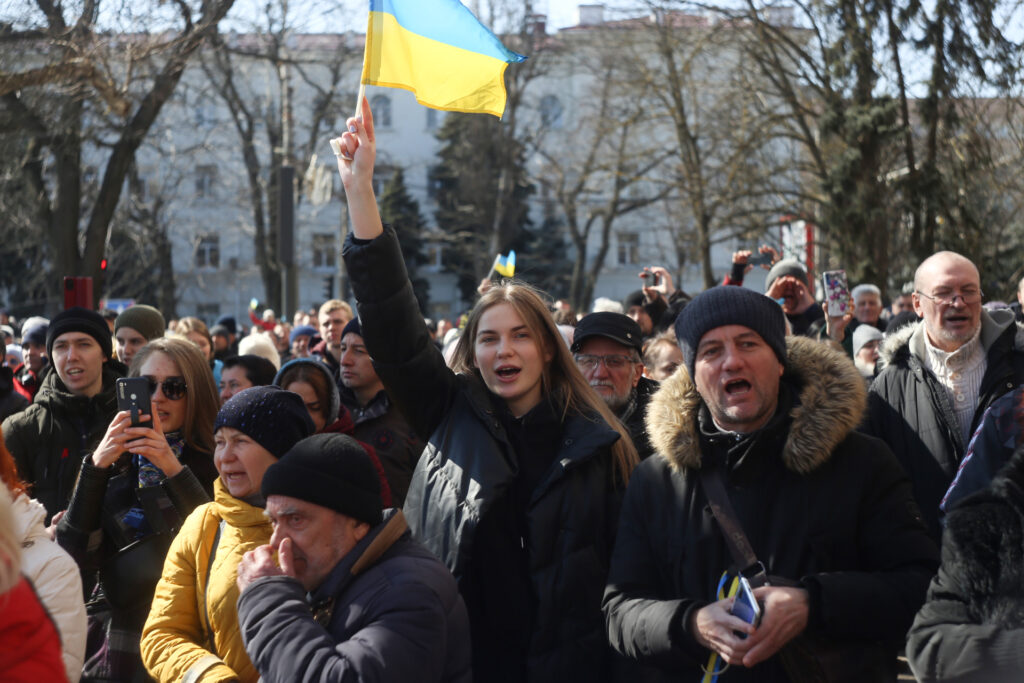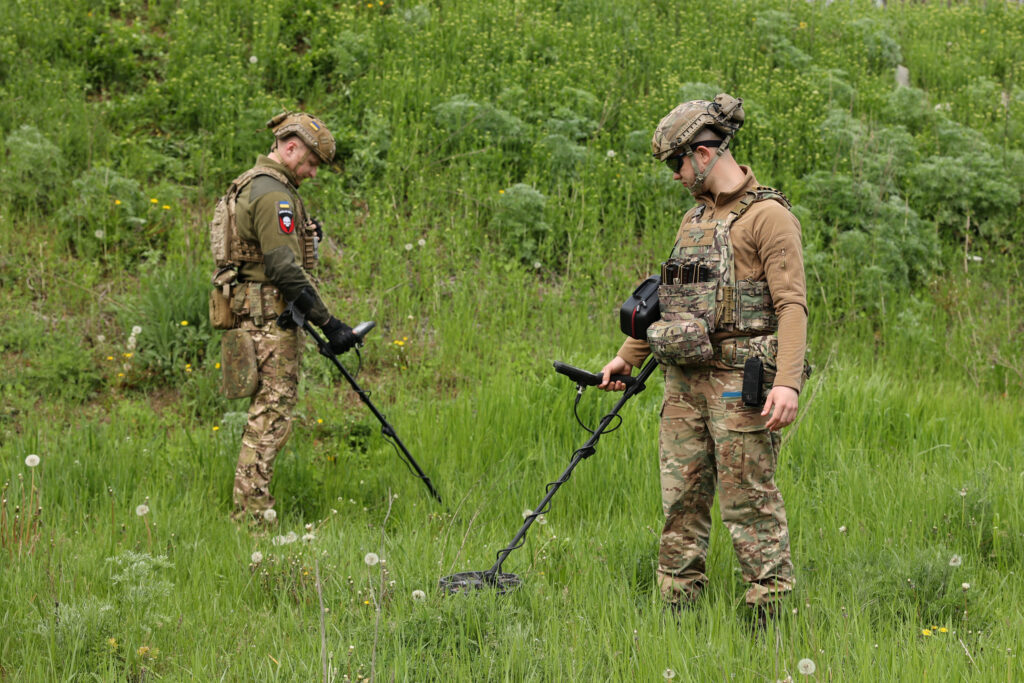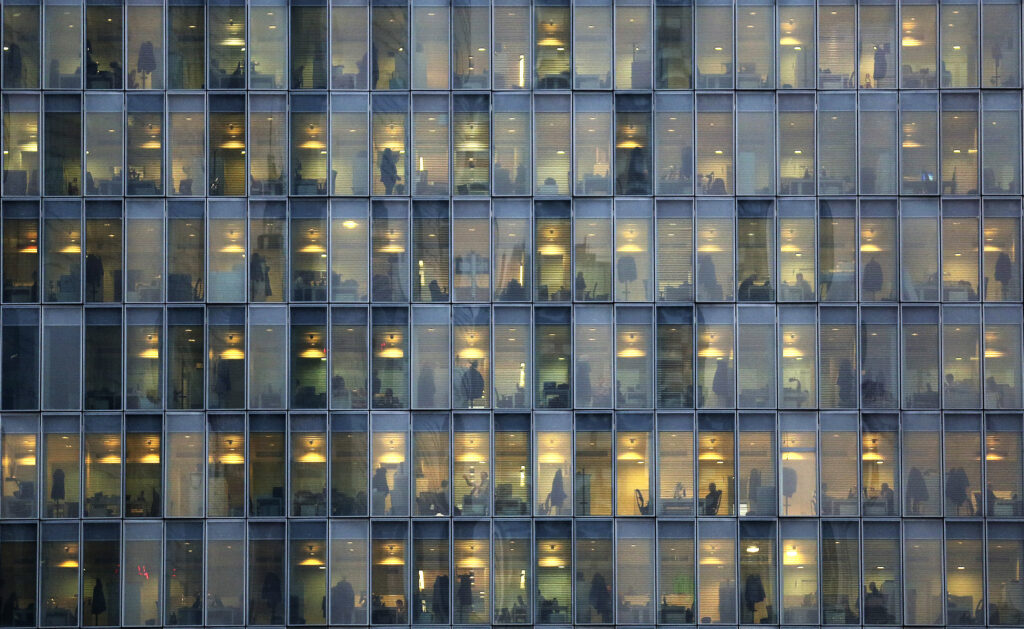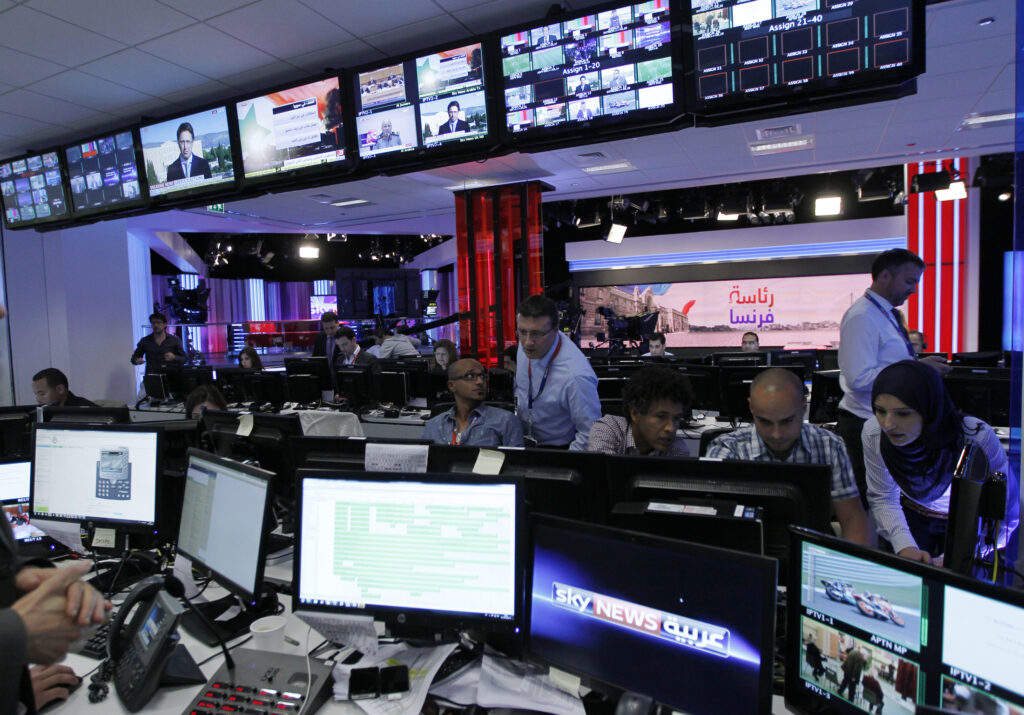
Oleksandr Kornyakov is a Ukrainian photojournalist who works for ’Vgoru’, an online independent media outlet based in Kherson. The Thomson Reuters Foundation (TRF) has supported Vgoru since 2020 as part of its work to strengthen independent media around the world. In the wake of the full-scale invasion of Ukraine, TRF adapted its support to ensure that its newsroom partners in Ukraine were able to continue operating – providing emergency grants, assistance with diversifying funding sources, as well as editorial training and mentoring.
During Russia’s full-scale invasion of Ukraine on February 24, 2022, Oleksandr was in the city of Kherson, where he lives and works. A few days later, on March 1, Russian troops captured the city. Through his photography, Oleksandr documented the reality on the ground, helping the world bear witness to civilian protests against their occupation, the suppression of demonstrations by Russian soldiers and what life was like in the occupied city. Oleksandr spent five months in Russian-controlled Kherson before he had to leave after being tipped off that Russian forces were looking for him. He returned to Kherson after the city’s liberation in November 2022, and continues to work there and take photos of life near the frontlines.
In the interview below, Oleksandr reflects on his experiences capturing the conflict. You can also read the interview in Ukrainian.
Oleksandr, how long have you been working as a photographer? How did you start your journey?
I have been working as a photojournalist since 2012. Initially, I came to work in Kherson as a system administrator for an online media outlet. But there was little work, and I was bored. I saw cameras in the office and offered to take pictures for the website. I did not have much experience but I was interested in photography as a child and previously worked for a year at a photo printing business. They gave me the camera and that’s how my career began.
Since March 2021, I have been working at Vgoru and continue to do so today.
What did you photograph before the war?
Life in Kherson. I photographed everything that happened in the city and focused on culture, sports, politics and social life. Between 2013-2014, I filmed protests in Kherson and Kyiv during the Revolution of Dignity, which was sparked after the government chose not to sign an agreement that would have integrated Ukraine more closely with the European Union. During that period, I started focusing on political events.
Where were you when the full-scale invasion of Ukraine began?
I was in Kherson.
Mentally, we have been preparing for war since 2014 when Russia annexed the Ukrainian peninsula of Crimea. In Kherson, we lived in constant tension from the possible attack from that direction, as the region borders Crimea. But the atmosphere was especially tense in the last weeks of February 2022. I even told the students at the media school where I was teaching photography that this could be the last day of peace. They told me, “It can’t be true”. But there was a real feeling in the air that something was about to change.
Nevertheless, February 24, 2022, caught me off guard. I had to decide whether to leave the city or stay, knowing that I could be in danger for having previously expressed a pro-Ukrainian position to those who opposed it. I remember listening to the news and hearing that the Russian forces were already near Kherson. I heard explosions. And I didn’t know what to do, where to run. There were few bomb shelters in Kherson but I didn’t even know where to find the closest one to my house.
But after that first day, I calmed down and had more clarity on what to do next.
What was happening in those first days of the war? Did you know at that point what role you were going to play?
I always go out with a camera. Even on February 24, 2022, I went outside and took a couple of photos. People began to buy everything: food, medicine and other necessities. I have never seen such queues in Kherson. When the Russians entered the city on March 1, 2022, I did not leave the house at all. But when the people of Kherson started protesting the Russian occupation, I went out every day with a camera and photographed everything that happened.
The atmosphere at the protests was incredible. I did not expect people in the city to go voluntarily as before the full-scale invasion, only around 200-500 people would come to patriotic events held in the city. But it was different this time. When I was approaching the gathering point for the protest, I heard a lot of noise. I came to the main square and it was almost full. There were many people with Ukrainian symbols. It seemed like thousands. Ordinary people were protesting, not because they were forced to but because they came together in national solidarity. It was very emotional.
I documented the events for Vgoru because it was my primary place of work. My photos and videos were also featured by the Associated Press and Al Jazeera but I had to ask these outlets to use my pseudonym, as captioning the photos with my full name would have put me in even more danger.

How did you feel photographing such important events?
It was hard to work. When I photographed small local events before, people usually knew me and understood that I was a photographer. But in this case, because there were so many people, everyone constantly asked who I was and why I was taking photos. It took a lot of time to explain my role as a photojournalist. But a week later, many people began to recognise and trust me, and it was then a lot easier to do my job.
You are more visible when you work as a photographer during a demonstration. I was worried that since I was so visibly photographing everything, and always had a camera, I might be named as one of the protest ’organisers’. At one point, Russian cameramen filmed me during the protests. I thought that that was the end for me, that they would establish who I was and come for me one evening. But luckily, they never came.
What was your experience of living and working during the Russian occupation of Kherson?
I spent five months in occupied Kherson.
After the Russian forces suppressed the protests, people began to leave the city. Some were arrested and tortured. Every day there were fewer and fewer people left in Kherson. And there was a time when I didn’t photograph anything at all because walking and taking photos on the street was impossible – you could only do that if you cooperated with the Russian authorities.
But then I decided to take photos with my phone. I began to shoot inconspicuously and had to be very careful because many Russian troops on the streets were dressed in civilian clothes and there were various checkpoints in the city where they checked phones. In May 2022, I stopped taking photos entirely as I had to go into hiding for six weeks.
Why?
Russian forces started looking for me.
One morning in May 2022, phone messages started pouring in from several acquaintances telling me that I could not return to my apartment. I took the warnings seriously and hid in my colleague’s apartment. Fortunately, I was not found.
To this day, I don’t know why they were looking for me. Maybe they wanted to offer cooperation or they wanted to arrest me. I don’t know for sure. But on the same day Russian forces had arrested a Ukrainian journalist in Kherson, one of my acquaintances who worked for a national Ukrainian TV channel. She was detained for a month.
When they started looking for me, I realised I had to leave the city. There was no longer an opportunity to stay and work there. Someone could recognise me on the streets and there was a network of torture chambers in the city, which have since been the subject of war crimes investigations. That’s why in the summer of 2022, I left, leaving most of my equipment behind. At the checkpoints, I was not identified as a photojournalist. I stayed in the territory controlled by Ukraine for a few months and returned to Kherson only after it was liberated.
When and how did you return to Kherson?
I returned to Kherson shortly after the city’s liberation in November 2022. At that time, it was impossible to enter the city freely as safety checks for booby traps and mines were taking place. But because I was an accredited journalist, I was able to be transported to Kherson on buses with other reporters. On that day, President Zelensky also came to the city, so there was a lot of press interest. At the end of the day, all the journalists gathered near the buses and someone said, “That’s it, let’s go back home”. And I remember saying, “I’m already home.” And so, I stayed.
After that, I travelled from time to time to other regions of Ukraine. Vgoru organised an exhibition – titled “Unconquered Kherson” – with my photos and it was held in 19 cities. But most of the time, I was in Kherson. I had returned.

Currently, Kherson is very close to the front line and is under frequent shelling. How are you working amid the dangerous situation in the city?
You probably can’t hear it now, but there are explosions outside the window (the interview is via Zoom).
At first, I was scared. I was not used to it. Once I came under three Russian attacks in just one day. My apartment building was also hit and damaged. It’s terrifying but somehow you get used to the fear. Recently, along with my colleagues, I went to photograph the consequences of a Russian attack on a bus stop where six people died. When we arrived, the Russians started shelling the same place again. My colleagues and I ran under the fence to hide. I wasn’t scared. When I looked at my colleagues, I saw that their hands were shaking. I then reflected that I also had a similar reaction at first. After experiencing similar attacks, I would walk and notice my legs shaking. But people adapt to everything.
What support would you like to see put in place for journalists such as yourself?
As a photojournalist, I always need equipment—and now more so than ever, additional protection. For safety purposes, I wear a bulletproof vest and a helmet. But if I can get a better vest, which will offer better protection and save my life, then I will not refuse. I don’t have my car now, as it stayed in the occupied part of the Kherson region. Right now, my friends drive me to locations of the shoots. But I would prefer to be more mobile.
Over one year on from the full-scale invasion, what is driving you to do your work?
During my life, I tried various professions. I started those jobs and learned a few things but quickly became bored. When I became a photojournalist, everything changed. Now there is something new every day. I feel needed. I like to work, to be in the whirlwind of all events. To be where not everyone can be. And this is the profession I have been looking for all my life. I will not change it even if I am offered a lot of money to do something else. I do not want that. I am interested in doing what I am doing now.
I will continue to work in Kherson. I plan to photograph what is happening in the city. I want to go to the temporarily occupied parts of the Kherson region once Ukraine liberates them. I may go to Crimea one day too.
I want to continue to work in the place where I was born.
More News
View All
AI Company Data Initiative drives transparency on corporate AI adoption
Now open for company…
Read More
Winners of the 2025 TrustLaw Awards Announced
This week marks the announcement of the 2025 TrustLaw Awards winners,…
Read More
How the Foundation is supporting LGBTQ+ communities worldwide
Over the last year, the Foundation has…
Read More
World Press Freedom Day: the need for the equitable and ethical adoption of AI
AI will be…
Read More
Case study: How an exiled Russian newsroom is using AI to combat news fatigue
Our Media in…
Read More
Five takeaways from the 2025 International Journalism Festival in Perugia
Remarkable solidarity…
Read More
How ‘foreign agent’ laws are silencing independent media
We explore the growing threat of ‘foreign agent’…
Read More
Unpacking the regional trends of the Index of Pro Bono 2024
We take a look at the long-term trends on pro…
Read More
2024 Index of Pro Bono findings revealed
The 2024 Index of Pro Bono, compiling comprehensive data representing nearly…
Read More
Journalists cautiously optimistic about the effect of AI on the profession, our new report finds
Our new TRF Insights report sheds light on the opportunities and challenges of AI…
Read More

